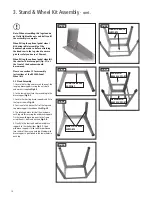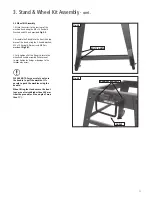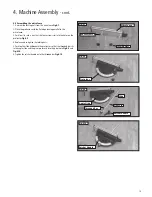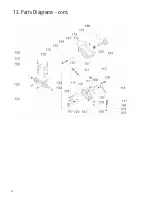
22
8. Operation & Bandsawing Practice
Basic Bandsawing Principles
• The blade cuts on a continuous down stroke.
• Slowly feed the workpiece towards the blade, using only light pressure
whilst letting the blade do the cutting. Always use a push stick and take
care.
• Firmly hold the workpiece and feed it towards the blade slowly, using the
push stick and keeping your hands well away from the blade.
• For best results the blade must be sharp. Damaged or worn blades should
always be replaced.
• Select the correct blade for the job, depending on the thickness of the
wood and the cut to be made (see blade selection).
• For straight cutting use the rip fence supplied.
• When cutting shapes, follow the design marked out by pushing and
turning the workpiece evenly. Do not attempt to turn the workpiece
without pushing it, as this may cause the workpiece to get stuck, or the
blade to bend.
Always ensure that your machine is properly maintained and clean. Before
commencing work on an important project, it is advisable to familiarise
yourself with the operation of the equipment by practising on low value or
scrap materials.
Complicated Cutting
Very complicated cuts and small radius curves are the best accomplished
with the aid of pre-drilled holes combined with a few tangential or radial
cuts. This technique will achieve excellent results without putting undue
tension on the blade and blade guide assembly.
CAUTION!
Particular care should be taken towards the end of the cut as
there will be a sudden decrease in resistance and care must be taken to
stop hands from being thrown towards the blade. Always use a push stick.
i
Kg
Restarting
In the Event of a Blockage or if the Machine Stalls
If the bandsaw stalls due to the blade becoming trapped in the work piece,
switch it off immediately by pressing the emergency stop button and wait
for the machine to come to a complete stop before proceeding further.
If the blade is trapped within the work piece, it may be necessary to prize
the work piece apart slightly using a suitable lever in order to free the
blade. If it is not possible to free the blade using this method, then it may
be necessary to cut the blade using suitable side cutters or tin snips.
Replace the blade if necessary and ensure that it is correctly tracked and
tensioned and that both doors of the bandsaw are fully closed and secured
before attempting to re-start the machine.
To re-start the machine, press the green button marked ‘I’ on the switch.
In the Event of a Power Failure
The bandsaw is fitted with a no volt release (NVR) switch to protect the
user against automatic starting of the machine when power is restored
after a power failure.
In the event of a power failure, first locate and rectify the source of the
failure. If the fault is within the power circuit of the workshop, there may
be an underlying cause (circuit overload etc.) that should be investigated
by a qualified electrician, before attempting to restore the power source.
If a cutting operation was taking place when the power supply was
interrupted, then it may be necessary to free the blade from the work piece
before attempting to re-start the machine.
Once the power is restored, the machine can be re-started by pressing the
green button marked ‘I’ on the switch.
Blade Selection (TPI)
The selection of the best blade configuration (see the table below) is
necessary for optimum cutting performance.
• Correct blade choice is primarily dependant on two factors: material
thickness and material type.
• Greater TPI should be selected as material thickness decreases.
• However, if the TPI is too great, the tooth loading will be insufficient
to enable penetration; and cutting. The teeth will also rapidly lose their
sharpness.
• For thicker material a lower TPI should be used otherwise the gullet will
not be sufficient to clear the waste and the blade will stall or burn the
wood.
• In general a minimum of 3 teeth should be in contact with the wood at
all times during cutting.
The accompanying blade selection chart (see the table below) gives
guidance on the TPI that should give the best results when cutting a variety
of material types and thickness. The table below provides recommendations
on selecting the correct blade for a variety of commonly used materials. If
in doubt about any aspects of blade selection contact
Customer Services in
your country.
The table provides a guide to selection only. Exact tooth configurations
are not always available, nor are all blade configurations covered, but the
principles remain the same. For special applications, custom blades can be
supplied please call Customer Services in your country.
WARNING!
In circumstances such as cutting deep or wet timber,
the work piece may close up behind the blade causing it to stall. In
the event that the blade stalls whilst cutting, ease the work piece
backwards slightly, to release feed pressure from the blade. Allow the
blade to reach full speed before continuing to feed the work piece in
to the blade. If the blade fails to move when feed pressure is released,
immediately switch off the machine and disconnect the power supply
before attempting to free the blade from the work piece.
WARNING!
If any component of the machine fails whilst in use or
if the blade should break whilst the machine is running, immediately
switch off the machine and disconnect from the power supply. Remove
the faulty component and replace only with genuine Record Power
replacement parts. Any electrical components should only be replaced
by a suitably qualified person. To replace a broken blade, please refer
to the section of this manual entitled “Band saw Blade Set Up”.
Always remember to fully release the blade tension mechanism before
attempting to fit a new blade. If you are in any doubt about using the
machine following a failure or if you need to order replacement spare
parts or blades, please contact Customer Services in your country.
i
Kg
i
Kg
Содержание BS300E Premium
Страница 33: ...33 13 Parts Diagrams cont ...
Страница 34: ...34 13 Parts Diagrams cont ...
Страница 35: ...35 13 Parts Diagrams cont ...
















































